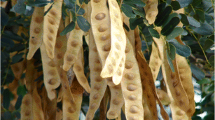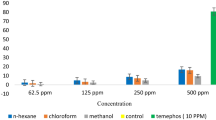Abstract
Aedes aegypti is responsible for the spread of various public health diseases and mostly synthetic insecticides are being used for its control. However, regular and over use of these substances has lead to mosquito resistance and environment contamination. Plant based products are natural alternatives to replace the commercial synthetic insecticides. This study was conducted to assess the ovicidal, larvicidal and pupicidal potential of the extract prepared from dried neem seed kernels against Aedes aegypti. Larvicidal activity of neem seed kernel extract (NSKE) was tested using five different concentrations viz., 100, 200, 300, 400 and 500 ppm against all four instars of Ae. aegypti. Ovicidal and pupicidal activity was evaluated by exposing fresh viable eggs and pupae to three concentrations of NSKE, below its effective larvicidal concentration i.e. 200, 300 and 400 ppm. Calculated values for LC50 were recorded as 49.96, 66.39, 77.19 and 83.57 ppm and for LC90 values were 186.53, 228.86, 286.69 and 358.02 ppm, respectively for LI, LII, LIII and LIV instars of Ae. aegypti till 48 hours of exposure to NSKE. Treatment of NSKE with 300 and 400 ppm showed 100% ovicidal activity and significant mortality of both male and female pupae in comparison to control sets. These results indicate that NSKE could be used as larvicidal, ovicidal and pupicidal plant based agent for the efficient control of Ae. aegypti in future.


Similar content being viewed by others
Data availability
All data and materials used in the study are either available from the corresponding author by request or have been used in this publication.
Code availability
Not Applicable.
References
Adeyemi MM (2010) The potential of secondary metabolites in plant material as deterrents against insect pests. Afr J Pure Appl Chem 4:243–46
Aliero BL (2003) Larvaecidal effects of aqueous extracts of Azadirachta indica (neem) on the larvae of Anopheles mosquito. Afr J Biotechnol 2:325–327
Alouani A, Rehimi N, Soltani N (2009) Larvicidal activity of neem tree extract (Azadirachtin) against mosquito larvae in the Republic of Algeria. J Biol Sci 2:15–22
Bar A, Andrew J (2013) Morphology and morphometry of Aedes aegypti adult mosquito. Annu Res Rev Biol 3(1):52–69
Becker N, Petric D, Zgomba M et al (2010) Mosquitoes and their control. 2nd edn Springer Publication, pp.9-40
Bibi R, Tariq RM, Rasheed M (2020) Toxic assessment, growth disrupting and neurotoxic effects of red seaweeds’ botanicals against the dengue vector mosquito Aedes aegypti L. Ecotoxicol Environ Saf 195:1–12
Carvalho DO, Nimmo DD, Naish N, Mckemey AR (2014) Mass production of genetically modified Aedes aegypti for field releases in Brazil. J Vis Exp 4:1–10
Chapman RF (2013) The Insects: structures and function. Cambridge University Press, Cambridge, p 929
Choudhary S, Yamini NR, Yadav SK et al (2018) A review: Pesticide residue: cause of many animal health problems. J Entomol Zool Stud 6(3):330–333
Djenontin TS, Wotto VD, Avlessi F et al (2012) Composition of Azadirachta indica and Carapa procera (Meliaceae) seed oils and cakes obtained after oil extraction. Ind Crops Prod 38(1):39–45
Finney DJ (1971) Probit analysis, 3rd edn. Cambridge University Press, Cambridge, pp 68–72
Gbotolorun SC, Osinubi AA, Noronha CC et al (2008) Antifertility potential of neem flower extract on adult female Sprague - Dawley rats. Afr Health Sci 8:168–173
Govindarajan M, Mathivanan T, Elumalai K et al (2011) Ovicidal and repellent activities of botanical extracts against Culex quinquefasciatus, Aedes aegypti and Anopheles stephensi (Diptera: Culicidae). Asian Pac J Trop Biomed 1:43–48
Gratz NG (1999) Emerging and resurging vector-borne diseases. Annu Rev Entomol 44:51–75
Hemingway J (2019) Resistance: A problem without an easy solution. Pestic Biochem Physiol 15:73–75
Isman M (2006) Botanical insecticides, deterrents and repellents in modern agriculture and an increasingly regulated world. Annu Rev Entomol 51:45–66
Kaur N, Kocher DK, Sidhu A (2019) Synthesis and testing of Eucalyptus globulosa oil based nanoemulsion for its larvicidal potential against Aedes aegypti. Afr Entomol 27(2):433–438
Kaura T, Mewara A, Zaman K et al (2019) Utilizing larvicidal and pupicidal efficacy of Eucalyptus and neem oil against Aedes mosquito: an approach for mosquito control. Trop Parasitol 9(1):1–6
Lardeux F, Riviere F, Sechan Y et al (2002) Control of the Aedes vector of the dengue viruses and W. boncrofti. Ann Trop Med Parasitol 96:105–116
Levy SM, Falleiros AMF, Gregorio EA, Arrebola NR, Toledo LA (2004) The larval midgut of Anticarsia gemmatalis (Hubner) (Lepidoptera: Noctuidae): light and electron microscopy studies of the epithelial cells. Braz J Biol 64:633–638
Mavundza EJ, Maharaj R, Chukwujekwujekwu JC et al (2013) Larvicidal activity against Anopheles arabiensis of 10 South African plants that are traditionally used as mosquito repellents. S Afr J Bot 88:86–89
Mayer SV, Tesh RB, Vasilakis N (2017) The emergence of arthropod-borne viral diseases: A global prospective on dengue, chikungunya and zika fevers. Acta Trop 166:155–163
Moreira MF, Dos AS, Marotta HR et al (2007) A chitin-like component in Aedes aegypti eggshells, eggs and ovaries. Insect Biochem Mol Biol 37:1249–1261
Murugan K, Jiang-Shiou HK, Kovendan K et al (2011) Use of plant products and copepods for control of the dengue vector Aedes aegypti. Hydrobiologia 6:331–338
NVBDCP (2022) Dengue situation in India (online). Website https://nvbdcp.gov.in/index4.php?lang=1&level=0&linkid=431&lid=3715
Ragavendran C, Manigandan V, Kamaraj C et al (2019) Larvicidal, histopathological, antibacterial activity of indigenous fungus Penicillium sp. against Aedes aegypti L. and Culex quinquefasciatus (Say) (Diptera: Culicidae) and its acetylcholinesterase inhibition and toxicity assessment of zebrafish (Danio rerio). Front Microbiol 10:427
Riat AK, Kocher DK (2017) Study of histoarchitectural changes in Anopheles stephensi larvae following exposure to Eucalyptus globulus and Aloe vera oils. Turk J Zool 41:763–773
Robertson JL, Russel RM, Savin NE (1980) POLO: a user’s guide to probit or logit analysis. Pacific South-West Forest and Range Experiment Station, Berkeley, USA
Russell BM, Kay BH, Shipton W (2001) Survival of Aedes aegypti (Diptera: Culicidae) eggs in surface and subterranean breeding sites during the Northern Queensland dry season. J Med Entomol 38:441–445
Sagar SK, Sehgal SS (1996) Effects of aqueous extract of deoiled neem (Azadirachta indica A. Jtss) seed kernel and karanja (Pongamia glabra Yent) seed kernel against Culex quinquefosciatus. J Commun Dis 28:260–269
Salehzadeh A, Akhkha A, Cushley W et al (2003) The antimitotic effect of the neem terpenoid azadirachtin on cultured insect cells. Insect Biochem Mol Biol 33:681–89
Schmutterer H (1990) Properties and potential of natural pesticides from the neem tree, Azadirachta indica. Annu Rev Entomol 35:271–297
Shaalan EAS, Canyon D, Younes MWF et al (2005) A review of botanical phytochemicals with mosquitocidal potential. Environ Int 8:1149–1166
Su T, Mulla MS (1998) Ovicidal activity of neem products (azadirachtin) against Culex tarsalis and Culex quinquefasciatus (Diptera: Culicidae). J Am Mosq Control Assoc 14(2):204–209
Valarmathy D, Govindaraj M, Elumalai K (2011) Studies on ovicidal activity of plant essential oil formulation against the eggs of important vector mosquitoes, Anopheles stephensi (Liston), Culex quinquefasciatus (Say) and Aedes aegypti (L.) at laboratory condition. Int J Curr Res 6:378–381
Wilder-Smith A, Gubler DJ, Weaver SC et al (2017) Epidemic arboviral diseases: priorities for research and public health. Lancet Infect Dis 17(3):101–106
Acknowledgement
Authors are thankful to the Head, Department of Zoology, for providing all the necessary facilities and Department of Science and Technology, Government of India, New Delhi, for providing infrastructural facilities under FIST grant and also to Dr Sarita Kumar, Professor of Zoology, Department of Zoology, Acharya Narendra Dev College, New Delhi (India) for providing eggs of Ae. aegypti for the conduct of ovicidal study.
Author information
Authors and Affiliations
Contributions
The idea of the research was conceptualized and designed by D K Kocher and the experiments were conducted by N Kaur. Data was recorded by N Kaur and it was analysed and compiled in the form of research paper by both the authors. Draft of MS was prepared by both the authors and it was revised and finalized by D K Kocher.
Corresponding author
Ethics declarations
Ethics approval
Not applicable.
Consent to participate
Not applicable.
Consent for publication
Not applicable.
Conflict of interest
The authors declare that they have no competing interest
Additional information
Publisher's Note
Springer Nature remains neutral with regard to jurisdictional claims in published maps and institutional affiliations.
Rights and permissions
Springer Nature or its licensor (e.g. a society or other partner) holds exclusive rights to this article under a publishing agreement with the author(s) or other rightsholder(s); author self-archiving of the accepted manuscript version of this article is solely governed by the terms of such publishing agreement and applicable law.
About this article
Cite this article
Kaur, N., Kocher, D.K. Ovicidal, larvicidal and pupicidal potential of neem seed kernel extract against Aedes aegypti L.. Int J Trop Insect Sci 43, 1089–1096 (2023). https://doi.org/10.1007/s42690-023-01020-8
Received:
Accepted:
Published:
Issue Date:
DOI: https://doi.org/10.1007/s42690-023-01020-8




